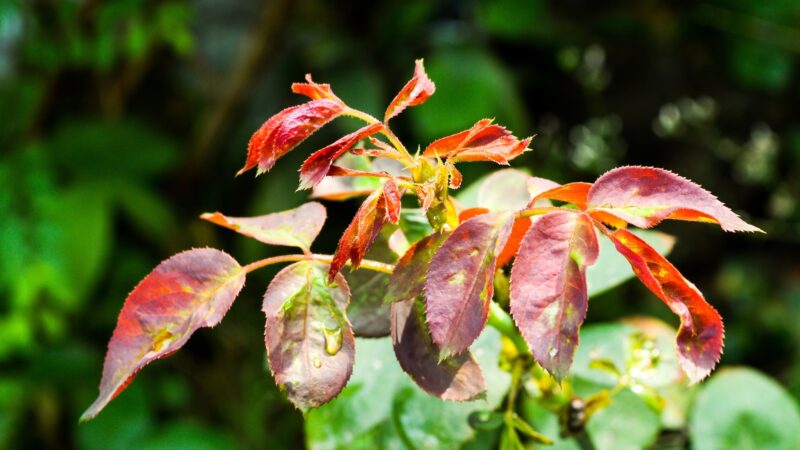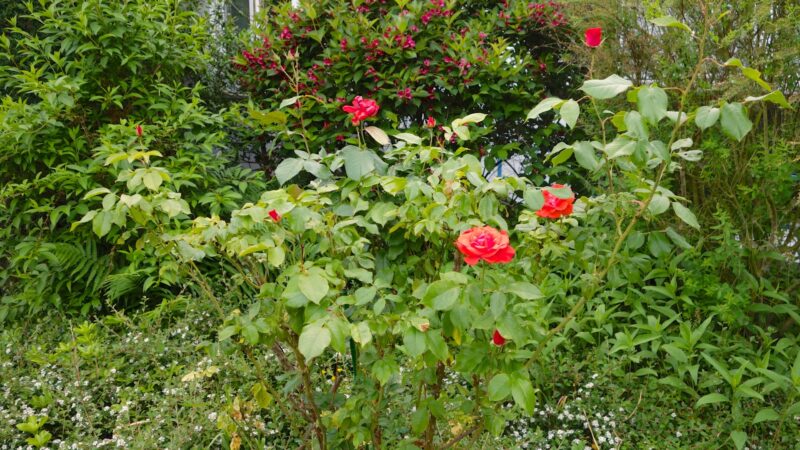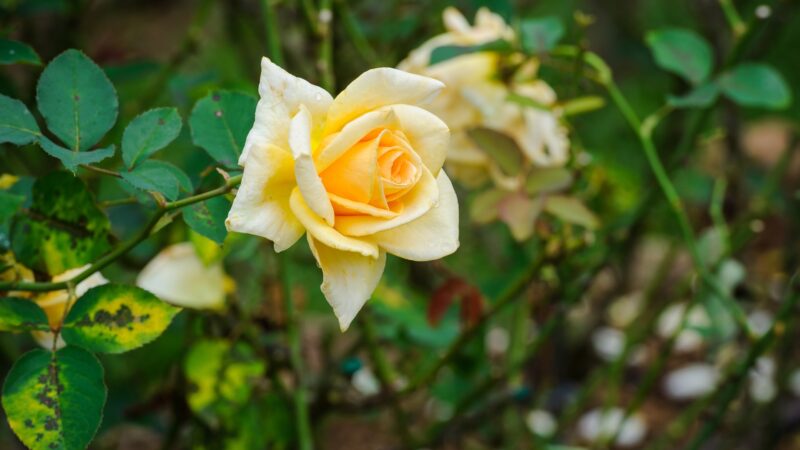Without a doubt, roses are among the most popular flowers out there. Whether as an ornamental plant or arranged in a bouquet, roses are known for their beauty and aromatic fragrance.
With that said, growing roses can be quite an investment. And to make sure that they’re healthy, you should watch out for yellow leaves – usually the first sign that there’s something wrong with your rose plant.
Rose leaves turning yellow due to too much fertilizer, nutrient deficiency, soil pH-iron deficiency, drought stress, too much water, not getting enough light, overheating, too much shade, disease and pest infestation.
Now that you know the reasons why rose leaves turn yellow, you should also learn how to remedy them. Fortunately, this article will teach you exactly how to revive your rose plant – and prevent it from happening again.
Is It Normal for Roses Leaves to Turn Yellow?

It is not normal for rose leaves to turn yellow. Even during the autumn season when the leaves fall off naturally, these leaves remain green. Thus, if you ever notice yellow leaves on your rose plant, know that there’s something wrong and that you should take immediate action to remedy it.
Should I Remove Yellow Leaves From Roses?

It depends on where your leaves are planted. If your roses are planted indoors, then there’s no need to remove the yellow leaves since these can be revived.
The only exception is if the damage is too severe that the leaves are already starting to rot. In this case, the damage to the leaves can no longer be reversed, so the best option is to pluck them off.
On the other hand, if the leaves are planted outdoors, the yellow leaves can easily attract garden pests. Unfortunately, these pests can make matters worse for your rose plant, so in this case, it’s best to remove the yellow leaves to prevent an infestation from taking place.
Can Yellow Rose Leaves Turn Green Again?

Yellow rose leaves can turn green again. Once you have identified what caused the yellowing leaves, you can immediately take action to revive the same.
During this recovery period, make sure your rose gets adequate water and light to keep it healthy. And soon enough, your plant will regain its healthy green foliage.
Why Are My Rose Leaves Turning Yellow?
Too Much Fertilizer
Roses do not need fertilizers to survive, but feeding them during their growing season will help produce more blooms and thick, bushy foliage.
However, the common mistake that new rose gardeners make is that they tend to feed their roses with too much fertilizer. This often results in damaged roots due to the high levels of salt in the soil. And that results in yellow leaves with a droopy appearance. They also lose their glossy appearance.
Remedies:
Fortunately, overfeeding with fertilizer can be easily remedied. The first thing you have to do is to flush the fertilizer out of the soil.
To do so, pour distilled water until the soil looks muddy. But only do so when you’re sure that the pot is well-draining – otherwise, this will lead to soaked roots that will only make the leaves mushy.
To prevent this from happening, make sure to use a fertilizer that’s specifically targeted at making roses bloom, such as Jobe’s 09426 Granular Plant Food Flower & Rose. Also, make sure to use it according to the recommended dosage on the label to keep it from being overfed.
- Package contains 4 pounds organic flower fertilizer grains and is...
- Plant fertilizer is formulated with a 3-4-3 NPK to provide roses...
- Jobe's organic fertilizer contains no synthetic chemicals and are...
- Application is simple and should be done every 6 weeks or as...
- Jobe's organic fertilizer is easily measured to provide the right...
Related: 8 Best Rose Fertilizers | How to Apply Them?
Nutrient Deficiency
Like all plants, roses need nutrients found in the soil to survive. Aside from the usual nitrogen, phosphorus, and potassium, roses also need magnesium, iron, and calcium to survive. If they are planted in poor soil that does not contain these nutrients, they may not grow healthy, which can lead to yellow leaves.
Remedies:
To remedy this problem, you simply need to feed your rose with a balanced fertilizer. Preferably, one that’s easy to absorb, like the Miracle-Gro Pound Water-Soluble All Purpose Plant Food, so your plant can regain its glossy green foliage as soon as possible.
- For all flowers, all vegetables, trees, shrubs and houseplants
- Dual feeding action - feeds through both roots and leaves
- Use in either the Miracle-Gro garden feeder or watering cans
- Prevents overfeeding and burning when used as directed
High Soil pH
Roses thrive when the soil is slightly acidic or neutral because this type of soil helps break down nutrients for faster root absorption. In contrast, when the soil has high alkaline content, it takes a while for the nutrients and minerals to break down, so the rose bush isn’t getting the nutrients it needs. That results in dull-looking pale yellow leaves on your plant.
Remedies:
To remedy the soil’s high pH, the best solution is to add an acidifier into the soil, like the Southern Ag Soil Acidifier Pellets. This will help increase the acidity levels in the soil to make it more suitable for your roses. In doing so, make sure to follow the instructions on the proper dosage of the soil acidifier to prevent it from becoming too acidic.
No products found.
Also, it helps to have a soil meter handy to check when the pH levels are right for your rose. A pH level between 6.0 to 7.0 is ideal. With that said, a handy tool like the GLOOOB 4-in-1 Soil Moisture Meter will not only help you check the pH levels but will also help you check moisture levels in the soil.
No products found.
Drought Stress
Roses love being watered – they need a deep soak once or twice a week to survive. With that said, they will suffer from drought stress if they do not get enough water for prolonged periods. As a result, leaves not only turn yellow, but they might even turn brown and brittle if left dry for too long.
Remedies:
In the case of drought stress, the only remedy is to water your plant until the water seeps through the pot. This ensures that the soil stays moist to keep your plant hydrated. During its recovery period, you will have to water your plant more frequently until it looks healthy and fully recovered.
Overwatering
While roses love getting water, you should be careful about overwatering your roses. This usually happens either when you use soil that’s not well-draining or when the pot becomes clogged – both of which can cause soaked roots. And soaked plant roots always lead to root rot.
Unfortunately, when the roots on your rose bush start to rot, they will also attract fungal growth, pests, and a nutrient deficiency. Aside from yellow leaves, your rose bush will also have soggy stems and leaves that will look droopy.
Remedies:
In the case of an overwatered rose bush, it is best to stop watering your roses for a while and move them to a sunny place. This will help the soil to dry up faster and therefore prevent the roots from becoming soaked. Also, you may use a stick to poke holes in the soil to help it aerate and dry up faster.
But if the rose bush looks droopy and withered, there’s a chance that it is already suffering from root rot. In this case, you will have to uproot the rose bush and remove the damaged roots.
You should use garden shears with sharp blades like the Fiskars Gardening Tools Bypass Pruning Shears to ensure a swift rotting root separation without causing damage to healthy ones. Just make sure that they are sterilized before using them to avoid contamination.
- GARDENING ESSENTIAL: Steel blade plant shears ideal for a variety...
- MAXIMUM POWER AND PRECISION: Fiskars pruning shears with...
- SMART FEATURES: Garden Scissors- Heavy Duty, with self-cleaning...
- QUALITY GARDEN TOOLS: Designed to help you cultivate a better...
- INCLUDES: Fiskars Bypass Pruning Shears that make great clippers...
Once you have separated the healthy roots, you can transfer them into a new pot with new soil. Then, water it, as usual, to help it recover.
Not Enough Light
Roses thrive under direct sunlight. While it can survive days without getting enough light, its leaves will turn yellow because it’s not getting the energy it needs to produce glucose. As a result, its leaves will turn pale yellow. And if it does not get sunlight for extended periods, it will eventually wither and die.
Remedies:
The only way to remedy this problem is to transfer your rose bush to a place where it will consistently receive sunlight. On days when the rain seems never-ending, it’s best to invest in artificial lighting for your plants, such as the Grow Lights for Indoor Plants Growing. This will serve as an alternative source of light for your rose bush.
- ⏰【SMART CYCLE MEMORY FUNCTION】 An intelligent grow light,...
- 🍒【SUNLIGHT LED HIGH EFFICIENCY】 Our indoor plants grow...
- 🍓【3 SWITCH MODES & 9 DIMMING LEVELS】 Our indoor led plant...
- 🌱【STURDY GOOSENECK & LEAF SHAPE CLAMP】 The new version...
- 🌼【SAFETY FEATURES & BUILT TO LAST】 The LED grow light is...
Overheating
Roses grow better when the weather’s warm. Specifically, it thrives when the temperature ranges between 60 to 70°F. It can tolerate a few days when the temperature drops below or rises above this range.
However, when the temperature rise exceeds its tolerable period, it might suffer from overheating. As a result, its leaves will turn yellow or brown and it will look dry and brittle.
Remedies:
In the case of overheating, the best remedy is to move your rose bush indoors until it recovers. While it’s ideal for roses to get direct sunlight throughout the morning, it may be best to limit their exposure to six hours and move them back indoors to allow them to cool down. This is especially true during the hot summer days. Then, you may want to water your plant more often than usual to help it cool down faster.
Too Much Shade
While roses can be indoor plants, they should still get decent amounts of sunlight to help with their regular functions. When it is getting too much shade, it will not be able to absorb sunlight, and that results in a lack of vitamins and minerals needed to survive. It’s also not getting the heat it needs to help grow its thick foliage. That results in dull, yellow leaves and a generally weak plant structure.
Remedies:
Fortunately, this is easy to remedy. Simply place your plant where it gets direct sunlight during the day. This will not only help it revive the leaves, but it will also help boost your rose bush to develop more buds. You should also remember to water it regularly to ensure its best health.
Disease
The rose plant is known to be a high-maintenance plant. This is because it is prone to a variety of plant diseases, such as black spots, powdery mildew, and botrytis blight, among others. In most cases, these diseases are due to fungal infections. And since roses love water, fungal growth is sure to follow.
When your rose bush is suffering from a fungal disease, its leaves will turn yellow and will have black spots on them. In some cases, these yellow leaves will appear to be covered by a powdery substance.
Remedies:
When it comes to treating a rose bush suffering from a fungal disease, the best solution is to spray it with a reliable fungicide. A good option is the Earth’s Ally Disease Control for Plants, which specifically targets black spots, mildew, and blight, among others.
- TREATS AND CONTROLS PLANT DISEASE - Maintain the health of your...
- SAFE FOR PEOPLE, PETS & PLANET - Formulated with citric acid,...
- NO HARSH CHEMICALS – A safer alternative to harsh chemicals...
- ENVIROMENTALLY RESPONSIBLE – Earth’s Ally Disease Control is...
- CONSERVES THE BEE POPULATION – Earth’s Ally is committed to...
But if the damage seems too severe, it’s best to pluck out the leaves to allow for new growth – in addition to spraying it with fungicide.
Pests Infestation
Plants are usually at the bottom of the food chain, and rose bushes are no exception. Even with their thorns, roses are prone to pest infestations, with common pests like aphids, whiteflies, and spider mites attacking their stems, buds, and leaves for sustenance.
Unfortunately, a pest infestation deprives the plant of the nutrients it needs to survive. And that causes yellow leaves with tiny holes where the pests have chewed upon. It’s also easy to notice since you can see visible clusters of these pests all over your plant.
Remedies:
The only way to get rid of pests is to spray your rose bush with a pesticide like the Garden Safe Brand Houseplant & Garden Insect Killer. These pesticides work fast to kill insects and prevent them from coming back.
- CONTAINS BOTANICAL INSECTICIDES: Spray on roses, vegetables,...
- KILLS ON CONTACT: Kills aphids, tomato hornworms, green...
- PROTECTS YOUR WHOLE GARDEN: Use both indoors and outdoors.
- READY-TO-USE PEST CONTROL: Spray upper and lower leaf surfaces...
- APPLY AS NEEDED: Treat weekly or apply as needed to control...
To make sure there will be no pest infestation in the first place, make sure to get rid of dried leaves or rotten stems on your rose bush. These pests are attracted to rotting matter, so yellow, brown, or fallen leaves can easily make them run to your rose bush. Make sure the area is clean, so there will be no infestation to get rid of.
How to Prevent Your Rose Leaves From Turning Brown?
To prevent your rose leaves from turning yellow or brown, the key is to keep your rose healthy. Here are some pointers that you should bear in mind when taking care of your roses:
- Water. When you first plant them, they will need a daily deep soak to help establish their roots in water. As they get older, you may only need to soak them in water once a week – except during the hot and dry summers when they will need watering at least twice a week.
- Sunlight. Aside from water, roses also love to bask in the sunlight. As much as possible, place it where it can get direct exposure to sunlight for the whole morning.
- Soil. The ideal soil to grow rose bushes in is one that’s excellent at retaining moisture but is well-draining so as not to soak their roots. With that said, loam soil that has a neutral pH level is ideal for growing roses. Also, make sure to check the pot in case the draining holes get clogged.
- Temperature. As a sun-loving plant, it comes as no surprise that roses also thrive when the weather’s warm. The ideal temperature range for a rose is 60 to 70°F, so make sure that your rose bush is planted where it is not too cold. Particularly, it does not like temperatures below 32°F, so make sure to transfer your rose bush indoors once the temperatures drop during the fall and winter seasons.
- Humidity. Roses also prefer it when the humidity levels are high. If the moisture content in the air is between 60 to 70%, expect your rose bushes to thrive. But if the air is dry, the stomata in the leaves tend to close, and that’s as if your rose bush is unable to breathe. And when it can’t breathe, it will surely wither and die.
List of Sources
Our Rose Garden – https://web.extension.illinois.edu/roses/disease.cfm





